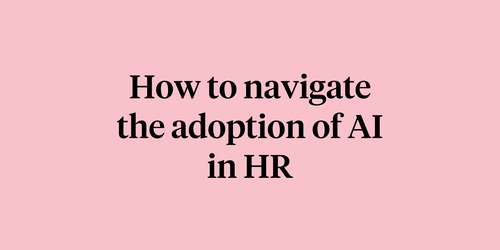
Written by

Director, Talent and Analyst Relations, Culture Amp
It’s that time of the year. Not Thanksgiving or Christmas, but time to think about trends and predictions for the New Year. We’ll likely see a lot of these articles this year.
So why is this article different?
As a Work Culture Evangelist, one of my favorite things to do is analyze seemingly disparate topics and connect the dots. It’s important to first say that I’m not making any predictions here. This isn’t an article about why 20% of your workforce will be a robot by the end of 2020.
This is an article where, with the support of Senior People Science Analyst Vivian Woo, I have looked at trends in workplace culture and analyzed them against nearly one million Culture Amp data points across over one thousand companies.
The following workplace trends are certainly not the only things you should be thinking about as we head into 2020, but they are certainly top of mind for me.
Trend 1: Mission-driven organizations
There are a few trends that I’m connecting the dots on here that makes this first trend relevant as we head into 2020. The platform economy, which Deloitte has defined as any type of digital platform that uses the internet to connect dispersed networks of individuals to facilitate digital interactions between people, has led to a growing number of the global workforce to have the chance to separate themselves from just one organization. The ability to work for several companies at once is a big shift from the longer average tenure that has been consistent in previous generations of workforces. We’re also seeing a shift away from just talking about corporate social responsibility and the triple bottom line.. But having a higher purpose and working towards an infinite game is much bigger, with CSR being only one component of this. After looking at Culture Amp’s 2019 global benchmark data, we found that alignment with the mission and purpose of a company is becoming table stakes. Employees don’t want to work for a company they don’t align with, value-wise. Take note leaders, just having a company vision doesn’t cut it. You still need to communicate that vision in a way that motivates your employees.
Data dive:
Contribution to a Broader Purpose is the highest-scoring factor (91% fav) by 11pts. Where this gets interesting is that people who scored high in this factor are more engaged (+15 pts) than those who are low in this factor. “When employees are looking to join a company, the only real insight they have is what the company does. If the employee doesn't agree with what they do (like a tobacco company), they won't want to work there. That's why this factor is so high - people self-select into companies they typically believe in. If there is a clash between the company's purpose and the employee's values, we see this lowering of engagement,” explains Vivian.
Leadership also plays a significant role in helping employees understand the mission that they are working towards. This all comes down to how they are communicating to employees. When answering the question, “Leaders at the company have communicated a vision that motivates me,” 67% of employees in our benchmark answered favorably with 23% responded with neutral. These scores might seem low, but a higher proportion of neutral responses indicates potential uncertainty or even mixed messages. The vision may be strong, but the communication might not be.
Get the data you need to prepare for 2020
See how Culture Amp’s platform can set you up for success
Trend 2: Agile learning organizations
Agile HR and Agile Learning organizations is a topic that has been close to my heart for a long time. I started my career over a decade ago in the corporate learning and development department of a government agency. We were trying to roll out learning programs, capability mapping and skills development to 65,000 employees. Not an easy task. For a long time organizations have been using on-premise Learning Management Systems (LMS) in order to deploy learning solutions.
This is not going to cut it in 2020. The way we are learning is changing and it’s time to use software at work that matches the experience we have with technology that we use in the rest of our lives. It also doesn’t make sense for us to only be recognized for the formal learning that we undertake. Agile learning organizations understand that employees can and should be learning in the following ways. Learning from on the job experience, learning from the skills of other employees and continuously upskilling the current skills you have.
Data dive:
We looked at 85 new tech organizations and compared the top 10% new tech (42 companies) to the bottom 10% new tech (43 companies) in terms of their engagement scores and relationship to learning. As Vivian says, “Comparing the top 10% engaged companies to the bottom 10% engaged is a proxy for ‘good culture’ versus ‘poor culture.’ The assumption is that a good culture would be more conducive to agile learning than a poor one.”
The biggest gaps between the top 10% of engaged companies and the bottom 10% of engaged companies are in the areas of the value of people, contributions to development, and acting on new ideas. Let’s look at some of the biggest differences based on employee engagement survey questions.
Question: The leaders at my company demonstrate that people are important to the company’s success.
There is a 41 point difference between top (90%) and bottom (49%) companies. “This means that the most engaged companies have leaders who show people are important. Regarding agility, it all starts with the people. How can leadership expect its employees to be agile if they don't show that they matter?” says Vivian.
Other questions related to learning in the employee engagement survey show the following differences:
- I am given opportunities to develop skills relevant to my interests
- 22 pt difference between top (78%) and bottom (56%)
- I have access to the learning and development I need to do my job
- 22 pt difference between top (77%) and bottom (55%)
- My company is a great company for me to make a contribution to my development
- 29 pt difference between top (88%) and bottom (59%)
Trend 3: Whole employee mapping
This is a new term that I’ve been speaking with companies about and is an extension of the idea of what it actually means to bring the whole self to work. In my podcast episode with Esther Perel she said something that really brought this idea to life. Employees are bringing all of themselves to the workplace, whether you want them to or not. If we can all agree this is happening, we need to have a clearer understanding of the ways in which we can help measure and understand the whole employee experience. A term that I’ve called Whole Employee Mapping. This looks at an individual's engagement, performance, effectiveness and willingness to learn new skills to really understand the opportunities for recognition, reward, growth and commitment. By looking at all of these data sets together, coupled with the knowledge that they are being impacted due to your experience inside and outside of the workforce we are able to better understand the employee experience in a holistic way. Ultimately, the more we understand about the entire experience we have at work, the more we can tailor the experience to ensure a higher retention rate. To understand why employees are thinking of staying or leaving their organization, we looked at our 2019 global benchmark data to understand the core themes that are linked to retention.
Data Dive:
When analyzing the employee experience, the themes that highly correlate with immediate and future retention focus on decision-making, career growth/development, leadership and future company performance, company priorities (including people) and investment. If you want to focus on retaining your people, these are good areas to focus on.
- I believe there are good career opportunities for me at my company
- My company effectively directs resources (funding, people and effort) toward company goals
- I am happy with my current role relative to what was described to me
- My company is a great company for me to make a contribution to my development
- The leaders at my company demonstrate that people are important to the company’s success
Trend 4: Remote organizations setting the standard for employee communications
Employee communications is often overlooked in terms of importance and under-invested in terms of priorities. David Gergen, a widely expert on the subject of effectively communicating key messages once said, "History teaches that almost nothing a leader says is heard if spoken only once." For employees to internalize the messages that we want them to hear, we need to repeat the message so often that you might grow sick of hearing yourself say it.
In my opinion, the best place for us to learn about how to get employee communications right, is remote organizations. Companies like Zapier and Buffer don’t rely on thinking people will be able to hear about things right the first time or through the grapevine. You can hear more about how Buffer and Zapier communicate and build relationships with remote employees in episode one of the Culture First Podcast.
Remote organizations also properly invest in helping employees communicate in a number of different settings. Gitlab put together a remote manifesto that helps their employees, and curious People Geeks like us, learn about how they work remote.
One of my favorite examples is their resource on communicating effectively and responsibly through text, useful information for any company, remote or not. Many organizations rely on in person meetings to get work done which can lead to silos forming, a lack of documentation and needing to be in a HQ office to feel included. Helping your employees communicate more effectively via text can help reduce the meeting culture that companies can develop and create a culture that documents everything.
We need to see communication as the most critical way to bring employees on the journey with you. When I asked Ambrosia Vertesi, former VP of People at Duo Security and Hootsuite, what is the role that communication plays to bring employees on the journey with you, she said, “There is no journey without communication.”
Data dive: In order to look at why you need to always be thinking about the importance of communication we analyzed our 2019 global benchmark data to see the drivers of employee engagement. Two of the highest drivers were questions related to leadership communicating a motivating vision. Because communication drives engagement, it should be a focus for all organizations.
Trend 5: Fluid organization design & teams
I’m a big believer in the power of a well-constructed team with clear goals, agreements and a container that allows for vulnerability and high trust levels.
The 2016 Deloitte Human Capital Trends Report surveyed over 7,000 companies from 130 countries and the number one issue on leaders' minds was “How to redesign our organizational structure.” Why should companies be moving to a more fluid approach? Bersin by Deloitte’s 2019 report, Six Top Findings for Designing Tomorrow's Companies Today, by David Mallon and Timothy Davis found that high-performing organizations are 19x more likely to regularly evaluate the degree to which their design is appropriate given the current external environment.
There’s a big difference between fluid organization structure by design and a lack of organizational structure, poorly defined goals and disparate communication across departments. I’m not evangelizing an increase in the reorgs of entire organizations, but I do believe that we should spend more time thinking about how to deploy smaller teams to achieve big goals.
One of the technology trends that is enabling a more fluid approach to how teams form is the rise of transparent goal and performance tracking. When there is a significant shift that requires a new team to form and respond, it helps to be able to map out the current projects and goals that people are working on quickly. This, along with team member skills help you decide on the right people to add to a team and the impact this will have on projects already in progress.
Data dive: We looked at data from our 2019 Benchmarks and focused on New Tech Organizations at the <200, 200-500 and 500+ employee sizes. The New Tech numbers tell a story of (mostly) young and fast-growing companies that are some of the most in-demand places to work in the world right now. We were able to identify indicators that a company should be looking to make changes to organizational and team structure based on their responses to employee engagement survey questions.
The smallest tech companies appear to have the fewest indicators that they need organizational changes, as they are lowest only in accountability and management of poor performers. They’re also more likely to be operating in a fluid manner due to smaller team sizes and constant change. As these companies scale up, what challenges do they face?
Mid-size tech companies have a number of indicators for restructuring - effectively directing resources, effective processes, employee involvement and leadership all score the lowest. Large tech companies have the greatest number of signals for change - cross-functional collaboration, effective processes, employee involvement, and management of poor performers were the lowest scoring. When we know these changes are coming, as an organization we need to be prepared to make the structural changes that will support our org and teams.
Getting ready for 2020
Ultimately what I’ve observed over the past decade of organizational design trends is that there is no one single structure or approach that we will all be trying to implement. Looking at the internal and external dynamics of the market and industry along with having a fluid approach to team design and projects does allow for us to respond with speed to the ever-changing pace of work that so many of us find ourselves in. We’d love to know how you are thinking about these topics as we head into 2020. Discuss them with me on this upcoming webinar.


